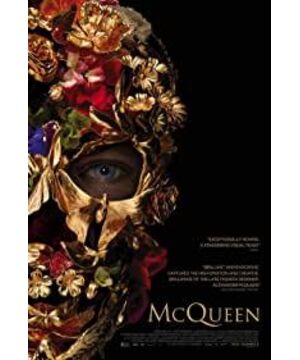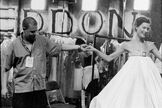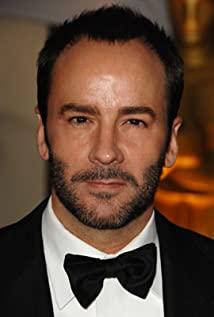Text | Zou Diyang
In the fashion circle where famous people gather, Alexander McQueen is destined to be an alternative existence. It is difficult for anyone who has a bit of involvement in this industry not to be shocked by his strange patterns and exaggerated shapes. These classic symbols that sway his personal style to the extreme are like a collection of treasures of his life's ingenuity. A few years after his death, he still outlines his full creative passion and image of an adventurer for us.
In contrast, the public has never known much about his ups and downs in his life, and has not spent much time investigating it in detail. Even in today's high-speed Internet, customizing your own social business card is no longer a new thing: when we mention Anna Wintour, the "fashion devil", we will first think of her powerful bob and sunglasses; talked about "Lafayette", the most eye-catching is naturally the king style hidden in the long braid of silver hair; and Tom Ford's elegant gentleman appearance and perfect arrangement of details during filming, in addition to the rich eye shadow palette and lipstick, Naturally, it strengthened people's impression of acting Virgo. Unlike these powerful industry helms, McQueen's face in people's eyes is always vague. As if he had cultivated a mysterious escape technique, he removed himself from all the glory, derogation, and controversy bred by his profession. Even if the fans who have long admired and followed and looked at him through chaotic gossip reports, they often got one-sided responses and uninteresting conversations.
At the Tribeca Film Festival in New York in April this year, the world premiere of the documentary "McQueen" directed by filmmakers Ian Bonholt and Pete Edgay, in this famous fashion circle " Eight years after "Bad Boy" committed suicide, he finally revealed a corner of his mystery. For those who are familiar with McQueen's experience before, the space for exploration in the film may be limited, but it is enough to provide an excellent opportunity for people who have just met him or are planning to meet him again. With five volumes of noisy video tapes and Michael Nyman's magnificent string music, the audience wandered through the major shows from the 1990s to the new century. Their eyes were tightly tied by the dream-like runway, and they were amazed by the ghosts. The designer's imagination is abundant, and at the same time he has gone through a roller coaster journey to the center of the earth, glancing at the endless sadness and loneliness in his heart.
The writer of dark fairy tales
Just like that memorable poster, the two most recognizable elements in McQueen's creations: skulls and natural creatures are combined creatively to release a strong and gorgeous grotesque atmosphere. Images similar to the 3D structure are interspersed in different passages in the film. They not only symbolize the famous brand in the fashion industry, but also a secret way to the designer's spiritual world.
Throughout McQueen's short career, many works are easily reminiscent of the black fairy tale series that went viral on the Internet in the past few years. Compared with the brightly colored and tailored neon clothes, he always uses the scale of shocking destructive power to transplant elements that deviate from the mainstream trend into his personal design. Just like the denial and rejection of the ideal land in the black fairy tales, McQueen also looks like a defector from traditional industries. The growing and mature fashion system in London, Paris and other places nurtured him and gave him a firm determination to start a new door. For him, choosing this kind of weird creative material has its own value and rationality beyond the definition of the times.
Except for the display of private life, the most inscribed in the film is still McQueen's intricate fashion shows during his lifetime. The collision between the top fabrics and the different-dimensional experimental field fully demonstrated his courageous talents and ideas. Even after many years, he is still full of jaw-dropping avant-garde. For example, the 1995 autumn and winter series "Rape in the Highlands" that made him famous overnight, ragged models appeared on the runway, dressed in torn skirts and ultra-low-grade buttocks, which instantly caused a sensation in the crowd, and the violence was incisive and vivid during the period. The portrayal of is almost a kind of visual encroachment. The next day, many media denounced it as "insults to women" and "absurd misogyny", thinking that this kind of vulgar hype fashion show is unforgivable.
There are also famous cases in the 2001 spring and summer series "Mental Asylum." McQueen used "Flying Over the Cuckoo's Asylum" as his inspiration to set up the show as a huge glass house for the mentally ill. Models with pale and mysterious makeup struggled to call for help. . After the "patient" exited, the glass curtain wall in the middle of the show fell down. The bloated erotic writer Michelle Olley wore a breathing mask and leaned naked on the bench, surrounded by hundreds of moths. This nightmare-like scene is so gloomy and cold, it looks like a surreal and weird oil painting.
With the passage of time, people began to accept McQueen's extraordinary design concepts and recognized the irreplaceable dialectics and thinking in his works. Just as he once fought back against "highland rape", he said, "The original intention of this show was to show the public what women did not give to men but were taken away from them. This is rape." This is well versed in survival. Zhidao thinkers have expressed in many interviews that they hope to see women become harder and stronger after wearing their own clothes, and be able to control their own destiny and resist the oppression brought by history and society. The love and repeated attempts of the evil line are just a means, not a "tyrant" aesthetic that is equivalent to the negative evaluations of pathology, narcissism, and sadism.
The gothic fairy tales dressed in the appearance of "Three Views of Destruction" are good at dispelling the utopian charms spread on the earth in a cruel way to break the expectations of all people, and approaching the real world full of dangers infinitely. Watching McQueen’s design exhibition, it is just such an experience. Those cramped corners and dark alleys are not only the wharf where evil spirits such as Jack the Ripper roam, but also the armor that tempers the will. As a bloody industry that has been criticized for a long time, fashion and violence are a pair of closely related phrases. It is the delicate balance found in the provocative, decadent, and sharpness of creation that allows the general public, who is shackled by the aesthetics of form, to jump out of daily life and touch the divine color infiltrated in fashion.
An artist who breaks through the mediocrity
Among the many little-known anecdotes of McQueen, the interesting one is that he loves Irish singer Sinéad O'Connor, "No one liked O'Connor at that time." His friend said in the film. This talented indie rock singer-songwriter is known for her rebellious temperament. She shaved her hair to refuse the packaging of record companies. Perhaps in her singing and complicated life, McQueen found a soothing resonance. And look back at the big-name artists who have worked with him or supported his designs: David Bowie, Björk, Lady Gaga, and most of them are quite famous "heterogeneous" on this planet. The avant-garde genes flowing in them are exactly what Qi Bao has. At the same time as the star halo, it is a living proof of the continuous expansion of artistic boundaries and the innovation of cultural trends.
If in the eyes of ordinary people, fashion is a high-threshold metaphysics that advocates fame and fortune, then McQueen's sequence of works can be called a magic mirror of the morbidity of the fashion industry. At the age of 27, he was hired as a designer for Givenchy and led the team to Paris, the fashion capital. The first show took the mythical Jason and the Golden Fleece as the starting point, and the color matching of the clothing echoed Givenchy's logo, but was condemned by the media as "indecent". After experiencing the fruitless blow of compromise, McQueen gave up pleasing the public, returned to London to start his own brand, and successively launched a number of enthusiastic themed shows such as "The World of the Weak and the Strong", proclaiming that he was decisively separated from the traditional fashion concept. Attitude. In the wild and primitive jungle, he re-be himself, the crazy-headed genius and artist.
In McQueen's design career, there is a certain kind of consistent mystery, but it is more of a variety of subjects and changing tones. This high degree of obsession and pursuit of the unknown world is undoubtedly related to his extensive exposure. Behind every big show that has received much attention, there is often a grand and far-reaching humanistic complex. Compared with most postmodernistic designers, he is not only satisfied with the flattened imagination, but with his eyes Penetrating out of the narrow fashion circle, investing in history, ecology, religion, war and other corners, absorbing sufficient nutrients from the fertile soil of reality, making the class and privileged attributes in the ready-made garments invisibly dismembered, thus evolving into a majestic infectious force. Symphony.
The McQueen Spring/Summer series conference in 1999 can be regarded as a stunning gift from McQueen to the world. The documentary restored this exciting moment: with the string version of "Death of Swan", the supermodel Shalom Harlow appeared on the finale. Wearing "No. 13" white dress, standing on the revolving stage in the center of the show, two robots spray paint on her dress. The cold equipment is grafted with the idea of imaginative freedom, and it becomes romantic and poetic in a flash. McQueen, who witnessed this scene, shed tears backstage, saying: "This is the first time I cried on my show." In nearly 40 performances to the public, he kept bringing amazing concepts to the stage: Joan of Arc, three-dimensional projection, chess board... While continuing to write about the miracles of the industry, while tirelessly practicing his ideas about fashion, contemporary art and ideal life.
In the documentary, Tom Ford, the creative director of Gucci at the time, watched McQueen’s design exhibition and said something intriguing: “He is a poet and a businessman. Because he is very realistic, he knows that he can express himself on the runway. , But the store’s hangers must have beautiful clothes for sale." The truth in the fashion industry is nothing more than this. Even though McQueen is still the street boy in the East End of London, he doesn’t know the data and trend lines piled up in the sales chain. Moved, it will eventually be swallowed up by the wave of commercial operations. After the Gucci Group threw an olive branch, he left Givenchy to devote himself to a new round of game rules. While his reputation is growing, the shadow that once made him has gradually become a demon that erodes his health.
The 2010 Spring/Summer show in Paris was named "Plato's Atlantis", referring to the unreachable dreamland that exists in ancient legends. Print stitching, horned hairstyle, armadillo shoes, and bell-shaped flower skirt together create a creative and unprecedented technological texture, expressing McQueen's vision of marine civilization and anxiety about the future of mankind, just like an apocalyptic oracle. After the catwalk, McQueen came up from the bottom of the stage and bursts of applause broke out among the seats. He did not realize that this fashion show, which marked the end of the first decade of the millennium and the digital transformation of the industry, became his swan song. .
Orphans who set off the prosperous fireworks
McQueen's family and friends call him "Lee", which is his original name. This boy, who was born in a taxi driver’s house, was 15 years old and was encouraged by his mother to go to London’s Savile Street as an apprentice. After entering the Saint Martin College of Art in London in 1990, his design level has improved by leaps and bounds, and then he was photographed by the famous "Hat Queen" Isabella Blow, renamed "Alexander" under his proposal, and has since stepped into the noble fashion industry.
Unlike Alexander the Great, who is endowed with royal blood, McQueen’s history is very similar to Hollywood's clichéd inspirational plot. Ambitious young people from slum neighborhoods accidentally broke into Vanity Fair and have since been on the same footing. But after all he is a child, even if he has been floating in the dye vat of the fashion circle for several years, he still has the humor and affinity that is unique to the bottom people. Catherine, a Givenchy tailor who had worked with him in Paris, recalled that one day McQueen took the initiative to invite her to the staff restaurant in the basement, and the staff went crazy when they saw him, "These fashion brands treat designers like kings. Treat, but McQueen doesn’t want to be a king, he just wants to be an ordinary person."
This perception of self-identity does not shrink sharply due to the expansion of the external environment. On the other hand, childhood trauma also cast a large shadow in his growth process. McQueen has been sexually assaulted by his teenage brother-in-law since he was 9 years old, and had to draw designs to escape the pain. The documentary did not avoid these negative parts, including the conflicts between him and his studio companions, the business entanglements between his lifelong and close friend Blow, and the gloomy years of middle-aged suffering from cocaine and AIDS. Many interviewees sporadicly In his narration, these scattered jigsaw puzzles regrouped again, accompanied by many inexplicable doubts, in the last half an hour, for us to piece together a lonely and depraved figure on the verge of self-destruction. The viewer couldn't help wondering how many secrets were sealed in his darkest spiritual corner?
Just like Faust, who signed a contract with the devil, some are destined to take the dark night as a protective color and go deeper in the struggle with the dark. And McQueen not only has dazzling talents, he is like a planet, which needs to keep turning to feed dozens of people. Outside of the relaxed studio, his smile is getting less and less, and his body condition is deteriorating every day when he opens and closes his house. No one can tell. When did he get tired of all this. When the media were busy making carnivals in the headlines of the newspapers, no one cared about his message to the world through the press conference: "My life has always been like Go up and down like a roller coaster, stop, I want to get off."
Being in the center of the bustling scenery, loneliness has spread and magnified exponentially, which seems to be the most paradoxical thing in the world. At the back of the documentary, McQueen stretched his smile for a rare occasion, in the countryside of East Sussex. In this DV interview, he revealed his attachment to the sea, to dogs, and to his family. This darling who has been touted to the cloud by the industry, what is most cherished in my heart is still the days of spending time with loved ones, comfort, tranquility, and rejection of all disturbing noises. So after the death of his best friend and mother one after another, Lee followed their footsteps and flew to the long-awaited pure land.
The look and feel of the whole film is extremely complicated. This complexity is not only due to the protagonist's dramatic life, but also related to the smooth transition of perspective. For such a legendary character, no matter how much material collage or biographical technique, it is difficult to accurately reproduce the arc drawn by his character, but it makes his image suddenly mysterious. As the end said: "No one can create more such wonderful costume shows than him." There are countless devout followers in the fashion circle, and there are always rising stars, but McQueen is unique.
This makes people think of another documentary about the fall of a superstar, "Amy", which is equally talented, but unable to contain the cry from the abyss, staggering towards destruction under the spotlight. People often blame the death of elites on media exposure and the ruthless oppression of individuals by popular industries. And all the devilish barriers may come from their inability to reconcile with themselves and the world, so they burn with all their strength, and then return to silence, like fireworks falling from a high altitude, leaving the world with a sigh.
Today, eight years later, the people who were fed by McQueen's "fashion garbage" are still filtering colors through layers and paying tribute to him with flowing water signs all over the street. Perhaps the best way to remember him is not to enshrine him in a shrine, but to understand the core of fashion he defined, or just to go out to observe nature and birds, embrace friends around him, accompany his family, and remember life Every moment the fire bursts.
View more about McQueen reviews











